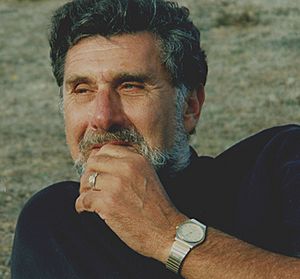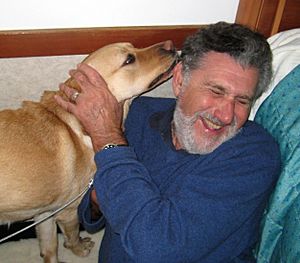Elliot Aronson facts for kids
Quick facts for kids
Elliot Aronson
|
|
|---|---|

Aronson in 1972
|
|
| Born | January 9, 1932 Chelsea, Massachusetts, U.S.
|
| Alma mater | Brandeis University Wesleyan University Stanford University |
| Known for | research on cognitive dissonance, high-impact experimentation, Jigsaw Classroom, gain–loss theory of attraction |
| Awards | AAAS Prize for Behavioral Science Research, APS William James Award |
| Scientific career | |
| Fields | Social psychology, applied social psychology, media psychology |
| Institutions | Harvard University University of Minnesota University of Texas University of California, Santa Cruz |
| Doctoral advisor | Leon Festinger |
| Doctoral students | Merrill Carlsmith, John Darley, Anthony Greenwald, Alexander Gonzalez |
Elliot Aronson, born on January 9, 1932, is a famous American psychologist. He is known for his important experiments on how people think and behave. He also created the Jigsaw Classroom, a special way of teaching that helps students learn together. This method also helps reduce arguments and bad feelings between different groups of students.
In his 1972 book, The Social Animal, he shared "Aronson's First Law." This law says, "People who do crazy things are not necessarily crazy." This means that sometimes, the situation a person is in can make them act in surprising ways.
Elliot Aronson is the only person in the 120-year history of the American Psychological Association to win all three of its main awards. These awards are for his writing, teaching, and research. In 2007, he received the William James Award for his lifetime achievements. This award recognized him as a scientist who "fundamentally changed the way we look at everyday life." A survey in 2002 ranked him as one of the most often mentioned psychologists of the 20th century. He officially retired in 1994 but still teaches and writes today.
Contents
Early Life and Education
Elliot Aronson grew up in Revere, Massachusetts, during a very tough time called the Great Depression. His family was the only Jewish family in their neighborhood. Because of this, he was often picked on by groups of kids on his way home from Hebrew school.
He believes that success in life comes from a mix of luck, chances, talent, and good instincts. Even though his high school grades were not great, his test scores were high. This helped him get a scholarship to Brandeis University, where he could work to help pay for his studies.
At first, he studied economics, like his father. But he changed his mind after he accidentally went into a psychology class taught by Abraham Maslow. After that class, he realized there was a whole science about the questions he had wondered about as a child. During his time at Brandeis, he met many respected psychologists. Maslow was his main teacher and had the biggest impact on his early studies.
Aronson earned his first degree from Brandeis in 1954. He then got his master's degree from Wesleyan University in 1956. There, he worked with David McClelland. In 1959, he earned his Ph.D. in psychology from Stanford University. His main teacher and guide there was Leon Festinger, a social psychologist.
Professional Career
Elliot Aronson has taught at several well-known universities. These include Harvard University, the University of Minnesota, the University of Texas, and the University of California, Santa Cruz. He also taught as a special visiting professor at Stanford University.
He was named one of the 100 most important psychologists of the 20th century. He was also chosen to be part of the American Academy of Arts and Sciences. He won the William James Award for his lifetime achievements in science. His other awards include special research honors from the American Psychological Association and the American Association for the Advancement of Science. He also won the Gordon Allport Prize for his work on reducing prejudice. In 1981, he was named "Professor of the Year" by a group that supports education.
Key Research Topics
Understanding Cognitive Dissonance
Elliot Aronson spent a lot of time studying and improving the idea of cognitive dissonance. This theory explains that people feel uncomfortable when their beliefs and actions don't match up. For example, if you believe littering is bad but then you drop a wrapper, you might feel this discomfort.
This uncomfortable feeling makes people want to change either their behavior or their belief. They do this so that everything feels consistent again. In one famous experiment, Aronson showed that people who went through a difficult or embarrassing process to join a group liked that group more. This was compared to people who joined easily. Aronson explained in 1973 that people are not always perfectly logical. Instead, they often try to seem logical to themselves and to others.
The Jigsaw Classroom Method
Aronson helped create a special way of teaching called the Jigsaw Classroom. This method helps reduce tension between different groups of students. It also helps students feel better about themselves. Before this, it was rare for students in classrooms to work together toward a common goal.
In 1971, schools in Austin, Texas, were facing problems. They had recently started mixing students from different ethnic backgrounds, and there was a lot of fighting. Aronson, who was teaching at the University of Texas, was asked to help. He noticed that the schools' very competitive atmosphere was making the ethnic rivalries worse.
Working with his students, he created a teaching plan to encourage shared goals and mutual support. In the jigsaw classroom, students are put into small groups. These groups are mixed with students of different backgrounds and abilities. They work together on a task. For example, if they are studying a historical figure, the material is broken into sections. Each student in the group is responsible for one section.
Students who have the same section from different groups then meet in "expert groups." They discuss their part of the material. After that, they go back to their original groups. Each student takes turns teaching their group what they learned. Finally, all students are tested individually on all parts of the material. This way of sharing responsibilities means students need to listen to each other. Each student also feels important to the group's success.
Studies showed that the jigsaw classroom helped students do better in school. It also improved their self-esteem and their attitudes toward other ethnic groups. This method has been used in many schools across North America. It started with younger students but has now been used at other school levels too. This success encouraged Aronson to use his research to help with other issues, like saving energy and treating older people better. After the Columbine High School massacre, Aronson suggested using jigsaw classrooms. He believed they could help fix social divisions that lead to school violence.
Gain–Loss Theory of Attraction
In 1965, Aronson suggested that how much we like someone can be understood by looking at rewards and costs. He believed that a change in how someone treats us, like getting more or less positive feedback, affects how much we like them more than just the total amount of good feedback. For example, a compliment from someone who is usually critical might mean more than one from a friend who always gives compliments. Another example is that a couple might feel more committed if they didn't like each other much at first but then grew to love each other.
The Pratfall Effect
In 1966, Aronson published a paper about an experiment he did. It looked at how a simple mistake affects how much we like someone. This is called the pratfall effect. It means that if someone makes a blunder, like spilling coffee, it can make them seem more or less attractive. This depends on how capable or skilled we already think that person is.
Awards and Professional Recognition
| Award | Awarding body | Year | Source |
|---|---|---|---|
| Award for Distinguished Research in Social Psychology | American Association for the Advancement of Science | 1970 | |
| Fellowship | Center for Advanced Study in the Behavioral Sciences | 1970–1971, 1977–1978 | |
| National Media Award | American Psychological Association | 1973 | |
| Teaching Award | University of Texas | 1973 | |
| Teaching Award in Psychology | American Psychological Association | 1980 | |
| Donald T. Campbell Award for distinguished contributions in social psychology | American Psychological Association | 1980 | |
| Professor of the Year | Council for the Advancement and Support of Education | 1981 | |
| Gordon Allport Prize for Inter-Group Relations | Society for the Psychological Study of Social Issues | 1981 | |
| Guggenheim Fellowship | John Simon Guggenheim Memorial Foundation | 1981–1982 | |
| Fellowship | American Academy of Arts and Sciences | 1992 | |
| Award for Distinguished Research in the Social Sciences | University of California, Santa Cruz | 1992 | |
| Distinguished Scientific Career Award | Society of Experimental Social Psychology | 1994 | |
| Distinguished Scientific Contribution Award | American Psychological Association | 1999 | |
| Master Lecturer | American Psychological Association | 2001 | |
| William James Fellow Award for Distinguished Lifetime Contributions to Scientific Psychology | Association for Psychological Science | 2007 |
Personal Life
Elliot Aronson is married to Vera Aronson. They met when they were both helping Abraham Maslow with his research. They have four children: Hal, Neal, Julie, and Joshua. Joshua is also a social psychologist, just like his father.
In 2000, Elliot Aronson was diagnosed with a condition called macular degeneration. By 2003, he had lost all of his central vision, meaning he couldn't see clearly in the middle of his eyesight. To help him with his blindness, Aronson decided to get a guide dog. He applied to Guide Dogs for the Blind in 2010. In January 2011, he started a three-week training program with his new guide dog, Desilu, who he nicknamed Desi. He finished the program on February 12, 2011. He joked, "They worked us 14 hours a day, until we were almost as smart as our dogs."
See also
- Insufficient justification § The forbidden toy experiment
- List of social psychologists



